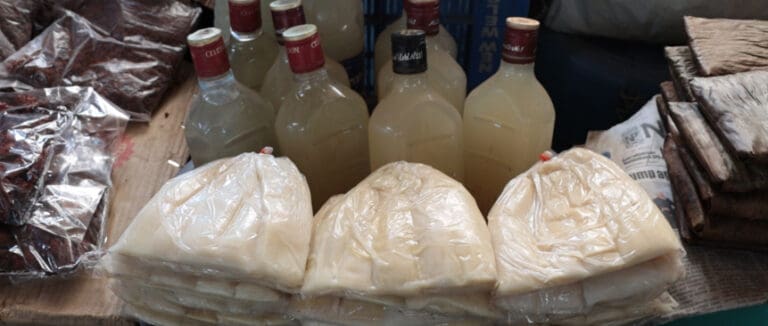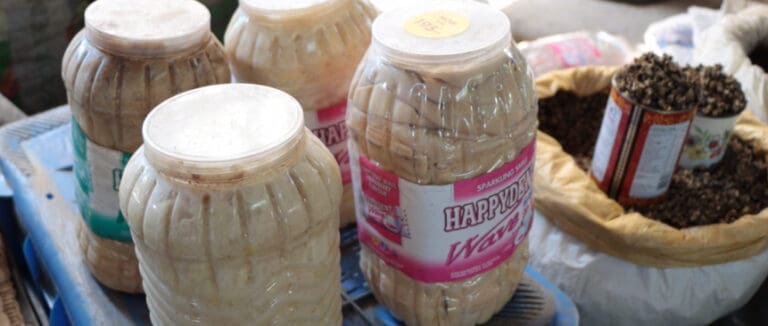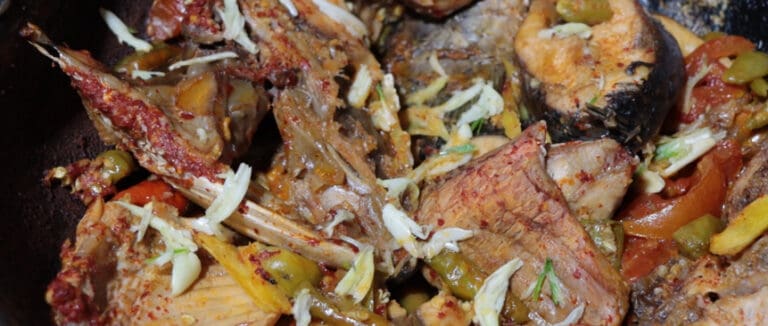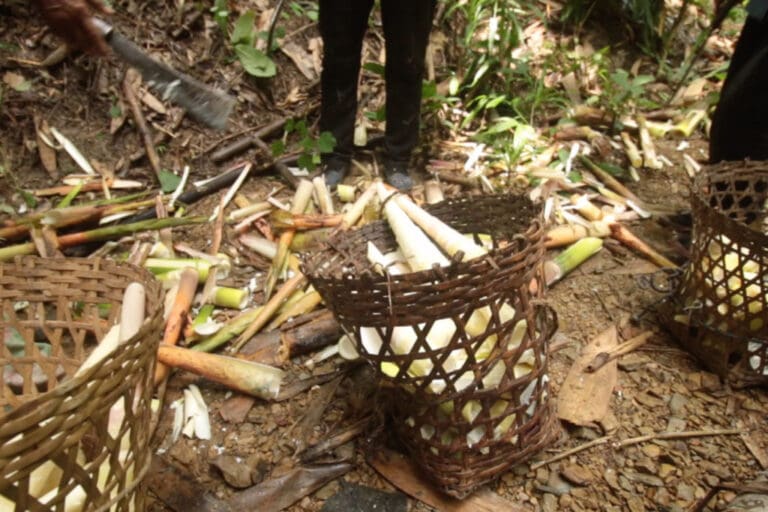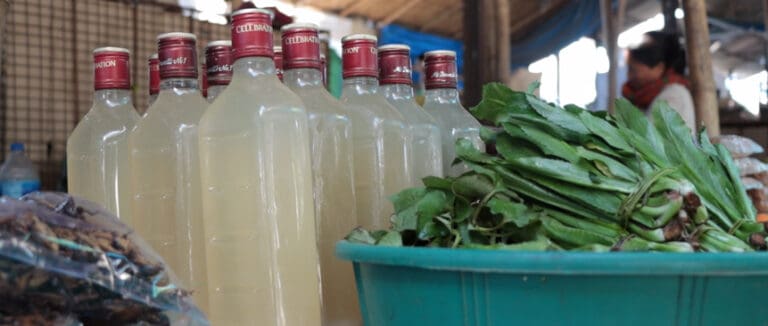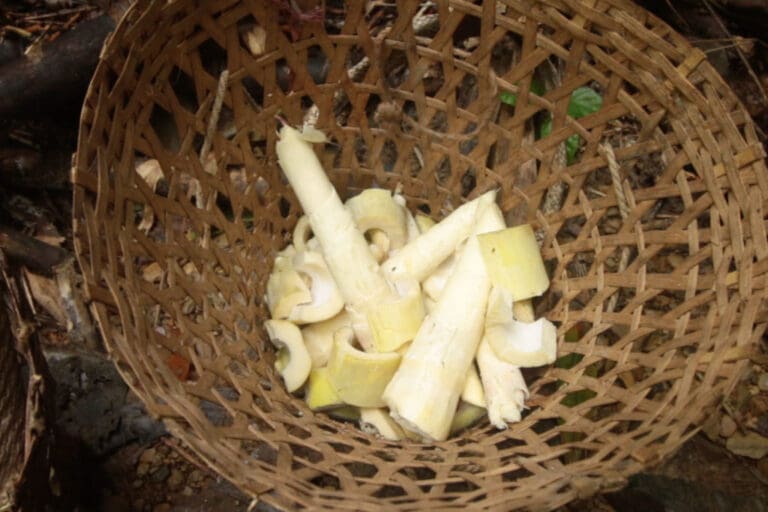Seasons of Life
Photo: Mhademo Kikon
Projects
Seasons of Life





Story
On a summer morning in August, Tsumungi and Pithunglo are off to the bamboo grooves in the forests of Ralan, a village in Wokha District of Nagaland. They call out to Yanchano to join them to harvest fresh bambooshoot along with them. They are a team.
Thousands of women in Northeast India forage and ferment food such as herbs, beans, and tender bambooshoot. The months for foraging tender bambooshoot depends on the elevations in this part of the Himalayan region. Foragers from mountaintop villages enter the forest by June looking for tender shoots to harvest, while across the middle and lower elevation the bambooshoot season extends until August.
Fermented bambooshoot is a delicacy as well as an everyday staple for many communities across Northeast India. It is an integral part of the food culture and links the region to its Southeast Asian and East Asian neighbours. In Nagaland and its neighbouring states like Manipur, Assam, Arunachal Pradesh, Tripura, Meghalaya, Sikkim, and Mizoram, bambooshoot is used in various forms: fresh, soaked in brine, and dried. As Pithunglo tells us, “Bambooshoot is like a spice to the Lotha Nagas.”
Seasons of Life follows Tsumungi, Pithunglo, and Yanchano, as they labour to forage and ferment tender bambooshoot, a food item cherished across several Himalayan households in South Asia.
Trailer
Team
Dolly Kikon / Producer and Director
P. Menangnichet / Cinematography
Menangnichet is based in Dimapur, Nagaland. With more than 15 years of experience, he has made several short documentaries and works as a freelance wedding videographer across Nagaland.
Mhademo Kikon / Cinematography
Mhademo is the founder and director of Feather Frames Production in Dimapur, Nagaland. He has a diploma in editing and videography from MAAC Institute in New Delhi. He regularly covers social events such as weddings, meetings, church gatherings, including funerals.
Hirak Jyoti Pathak / Editing
Hirak holds a degree in Animation and a diploma in Film and Video Editing. He works as a freelance editor in Guwahati. His first feature film as an editor, Pepper Chicken, is in post-production and will soon be out. Prior to this, he has worked on several documentaries and short films as an editor.
Trihangku Lahkar / Sound
With a diploma in Film Making, Trihangku specialised in Audiography and Sound Engineering. He loves to play the drums and has a Grade 3 certificate in Music Theory from ABRSM. He works as an Assistant Recording Engineer at The Sound Zone Studio in Guwahati. Seasons of Life is his third short film.
Ren Merry / Music
Ren Merry is a musician from Wokha district where Seasons of Life was shot. He studied in Dimapur and Shillong before completing his MA in Music Performance from the United States. He has taught music in Patkai Christian College (Dimapur) and Westminster Christian Academy (Louisiana). He lives with his family in Colorado where he teaches music.
Anthropology and Food
Seasons of Life is an extension on my work in Anthropology of Food, particularly fermented food. Food has always been my passion. While I conducted my ethnographic fieldwork for my doctoral work between 2009-2011, I discovered food in variant ways and how they symbolised everyday human relations and evoked memories and sociality. My first attempt to make sense of food was a short essay I wrote titled “Tasty Transgressions: Food and Social Boundaries in the Foothills of Northeast India”. The hills and valleys in Northeast India are known for specific and distinct food produce which can be exhibited as an extension of its unique culture. The exchange between the hills and valleys appeals to the senses of taste, sight and touch.
I learnt that the foothills, in contrast, are an ecotonal region whereby there is a rich culture of diversity – both in terms of ethnicity and also the choice of food practices. This fieldwork observation during my doctoral work along the foothills of Assam and Nagaland became an important analytical lens for me in the years to come. As much as the foothills of Assam and Nagaland are recognised as a physical and legal border, it is also a place where sensory perceptions attached to the taste of food as strictly belonging to the hills of Nagaland or to the Brahmaputra valley are constantly challenged. The daily practices around food taboo, transgression and boundary, I had noted, are not set in stone across the foothills. There is an engaging interplay of comparative exchanges and evolving recipes deviating from the traditional food practices. However, strict food taboos in conservative households were, for example, expanded (to include wild herbs or edible insects) to preserve religious and social convictions. In addition, food items and delicacies changed according to seasons, and food taboos were broken to match the sensibilities of the environment.
In 2015, I began to connect food with the armed conflict and the experiences of marketing food for a consumer market. I wrote “Making Pickles during a Ceasefire” with an aim to engage with sustainability, development, and the gendered world of fermentation. Furthermore, I examined issues of modernity, citizenship and belonging in my article on Akhuni, fermented soya beans, known by different names in Northeast India.
My memory of Akhuni is linked with my grandmother, Oreno. She grew up during World War II and told me stories about her experiences of the war that swept across the Naga Hills. Her memory of the Japanese soldiers who arrived there was a peculiar one. She was a young woman when soldiers came to her house in search of food and found packets of fermented soya beans. They wept before falling on their knees and devouring it. My grandmother’s generation vividly remembers their encounters with the Japanese soldiers who also took away livestock and grain from the village. The World War II drama in the Naga Hills was a consequence of multiple intersections, negotiations and staging of power and order globally, but among all the stories I inherited from my grandmother, there is something about this anecdote of the weeping Japanese soldiers eating fermented food that has stayed in my mind.
How does the same aroma that is a delicacy for some become repulsive to others? In what ways do fermented food highlight expressions of resistance, negotiation and anxiety? Why is it important to celebrate fermented food and reflect its significant role in our lives? These are some of the questions I engage with in my current work tentatively titled “Fermenting Cultures”.
In August 2019, I travelled to Ralan with my camera team to shoot Seasons of Life: Foraging and Fermenting Bambooshoot during Ceasefire. It is part of my research work on fermentation where I extend the notion of solidarity and bonding through sharing food and eating together. Today, bambooshoot is an integral part of ethnic restaurants that serve Northeast cuisine across India. This documentary traces its journey from the forests of Northeast India to kitchens and our plate.
Bambooshoots: Fresh, Fermented and Dried
Rich in protein, carbohydrates, vitamins, minerals, fibres, and low in fat, bamboo is known for several health benefits. Phytosterols in bambooshoots reportedly has youthful feeling, athletic energy and longevity to regular customers.
Fresh bambooshoots are cooked as vegetable when they are available during the foraging season. It is preserved in various forms for consumption throughout the year – dried, soaked in brine or pickled with spices and oil. These preserved forms are added to different dishes for flavour.
